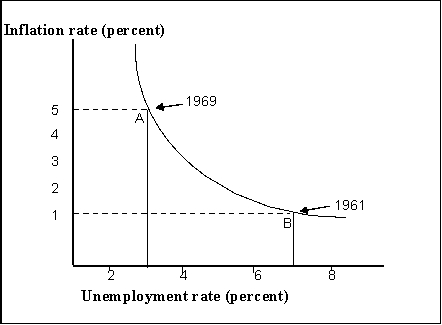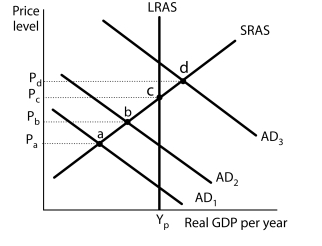A) vertical Phillips curve.
B) horizontal Phillips curve.
C) positively sloped Phillips curve.
D) negatively sloped Phillips curve.
F) B) and C)
Correct Answer

verified
Correct Answer
verified
Multiple Choice
Suppose the full-employment level of real GDP is increasing at a rate of 3% per period and the money supply is growing at a 3% rate.Using the equation of exchange, what is the value of the long-run inflation rate, assuming constant velocity?
A) 6%
B) 3%
C) 1%
D) 0
F) B) and D)
Correct Answer

verified
Correct Answer
verified
True/False
A decrease in the money supply will shift the AD curve to the left.
B) False
Correct Answer

verified
Correct Answer
verified
Multiple Choice
Along an actual (observed) Phillips curve,
A) aggregate output varies inversely with the unemployment rate.
B) aggregate output directly inversely with the inflation rate.
C) the inflation rate varies inversely with the unemployment rate.
D) the inflation rate varies directly with the unemployment rate.
F) A) and C)
Correct Answer

verified
Correct Answer
verified
Multiple Choice
Each point on a Phillips curve is a different combination of
A) aggregate output and the unemployment rate.
B) the inflation rate and the unemployment rate.
C) aggregate output and the inflation rate.
D) saving and disposable income.
F) All of the above
Correct Answer

verified
Correct Answer
verified
Multiple Choice
Suppose the full-employment level of real GDP is increasing at a rate of 4% per period.If policymakers are committed to keeping the long-run inflation rate at 3% per period, then what is the targeted money growth rate, assuming constant velocity?
A) 7%
B) 4%
C) 1%
D) -1%
F) A) and C)
Correct Answer

verified
Correct Answer
verified
Multiple Choice
Which of the following predictions can be made using the growth rates associated with the equation of exchange, given that velocity is stable and that the economy moves to its potential output (YP) in the long run?
A) If %∆M > %∆ YP , then %∆P > %∆M.
B) If %∆M > %∆ YP , then %∆P > %∆ YP.
C) If %∆M = %∆ YP , then %∆P = 0.
D) If %∆M = %∆ YP , then %∆P < 0.
F) A) and C)
Correct Answer

verified
Correct Answer
verified
True/False
The lowest wage that a worker would accept if offered a job is called the subsistence wage.
B) False
Correct Answer

verified
Correct Answer
verified
Multiple Choice
Figure 16-1
 -Refer to Figure 16-1.Consider point A where inflation is relatively high and unemployment
Is relatively low.In order to move down the curve toward point B, what fiscal policy measures should the policymakers undertake?
-Refer to Figure 16-1.Consider point A where inflation is relatively high and unemployment
Is relatively low.In order to move down the curve toward point B, what fiscal policy measures should the policymakers undertake?
A) decrease taxes and government spending
B) increase taxes and government spending
C) increase taxes and decrease government spending
D) decrease taxes and increase government spending
F) All of the above
Correct Answer

verified
Correct Answer
verified
Multiple Choice
Suppose an economy is operating with a contractionary gap.In this case, policymakers Would seek to move the economy
A) back down the Phillips curve, trading a reduction in inflation for an increase in unemployment.
B) up the Phillips curve, trading a reduction in inflation for an increase in unemployment.
C) back down the Phillips curve, trading a reduction in unemployment for an increase in inflation.
D) up the Phillips curve, trading a reduction in unemployment for an increase in inflation.
F) A) and D)
Correct Answer

verified
Correct Answer
verified
Multiple Choice
Rising inflation means
A) that the price level is increasing by a given percentage rate.
B) that the prices of all goods and services increase from year to year.
C) that the price level is rising at an increasing rate.
D) that the price level is rising at a variable rate.
F) B) and C)
Correct Answer

verified
Correct Answer
verified
Multiple Choice
Which of the following statements is true? Economists generally agree that
A) the rate of inflation in the long run is determined primarily by growth in government spending.
B) factors other than money growth may influence the inflation rate from one year to the next, but they are not likely to cause sustained inflation.
C) the primary cause of inflation is increases in the money supply growth that exceed growth increases in aggregate demand.
D) the major causes of inflation are declining productivity coupled with excessive spending.
F) A) and C)
Correct Answer

verified
Correct Answer
verified
Multiple Choice
Figure 16-1
 -Refer to Figure 16-1.Moving from B to A shows a tradeoff of
-Refer to Figure 16-1.Moving from B to A shows a tradeoff of
A) more unemployment for less inflation.
B) less unemployment for more inflation.
C) a fixed amount of unemployment for more inflation.
D) less unemployment for less inflation.
F) B) and C)
Correct Answer

verified
Correct Answer
verified
Multiple Choice
Consider the following statement: "President Carter expressed concern about reports of rising inflation but insisted the economy is on the right course.He pointed to recent reductions in unemployment as evidence that his economic policies are working." Which of the following could have caused this phenomenon?
A) Increase in government spending that shifted the aggregate demand curve to the right.
B) Increase in money supply which lowered interest rates and shifted the short-run aggregate supply curve to the right.
C) Economic agents revising their expectations about the price level resulting in the short-run aggregate supply curve shifting to the left.
D) Expansionary fiscal and monetary policies that shifted the long-run aggregate supply curve to the right.
F) C) and D)
Correct Answer

verified
Correct Answer
verified
Multiple Choice
Which of the following economists came up with a theory regarding the tradeoff between Unemployment and inflation?
A) Almarin Phillips
B) John Maynard Keynes
C) Joseph Schumpeter
D) Milton Friedman
F) B) and D)
Correct Answer

verified
Correct Answer
verified
Multiple Choice
What is a reservation wage?
A) It is the highest wage that an unemployed worker would accept, if it were offered.
B) It is the lowest wage that an unemployed worker would accept, if it were offered.
C) It is the highest wage that an employer will offer a potential worker if there are many candidates vying for the job.
D) It is the lowest wage that an unemployed worker would accept, excluding any non-pecuniary benefits.
F) None of the above
Correct Answer

verified
Correct Answer
verified
True/False
The relationship between inflation and unemployment suggested by the experience of the 1960s was supported by the facts of the 1970s and 1980s.
B) False
Correct Answer

verified
Correct Answer
verified
Multiple Choice
Which of the following determines the rate of inflation in the long run? I.the rate of money growth II.changes in expectations about the price level III.the rate of economic growth IV.changes in government spending
A) I and II only
B) I and III only
C) I, II, and III only
D) I, II, III, and IV
F) A) and D)
Correct Answer

verified
Correct Answer
verified
Multiple Choice
In the three phases of the inflation-unemployment cycle, during the Phillips phase,
A) inflation and unemployment both increase.
B) inflation and unemployment stay the same.
C) inflation and unemployment both decrease.
D) unemployment decreases and inflation increases.
F) All of the above
Correct Answer

verified
Correct Answer
verified
Multiple Choice
Figure 16-5
 -Refer to Figure 16-5.The shifts of aggregate demand from points a to b to c to d are Characteristic of which phase(s) of the inflation-unemployment cycle?
-Refer to Figure 16-5.The shifts of aggregate demand from points a to b to c to d are Characteristic of which phase(s) of the inflation-unemployment cycle?
A) the Phillips phase to the stagflation phase
B) the Phillips phase to the recovery phase
C) the Phillips phase
D) the Phillips phase to the stagflation phase and to recovery phase
F) None of the above
Correct Answer

verified
Correct Answer
verified
Showing 21 - 40 of 135
Related Exams